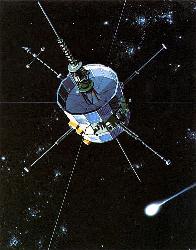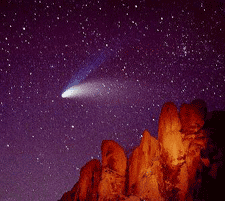

The design that came into being
was a small spinning spacecraft that would carry
inflatable plastic tubes. During the flyby the
tubes would be exposed to comet dust in the coma
of Halley. The particles would penetrate the tubes,
vaporize and the comet vapor would condense on
the inside of the tubes. This was called atomized
sample return and it would provide direct information
on the elemental and isotopic composition of Halley.
The mission was often called Halley Earth Return
or HER.
Another JPL Halley mission studied at that time
was called HIM, Halley Intercept Mission. Neither
HIM or HER ever got off the drawing board. The
US failed to be included in a spacecraft that
flew past Halley in 1986. ISEE was sent on its
many Lunar encounters and in 1985 it flew by comet
Giacobini-Zinner. Although it was still the same
spacecraft, it was renamed ICEE (International
Sun Earth Explorer) and it did make a distant
upstream journey near Halley. Although, it never
was close enough to detect the comet or collect
samples.

The Halley efforts did help produce the idea that
a low cost sample return mission could be done
from a comet. Unlike other bodies, comets release
matter into space, and a simple spacecraft just
flying by can snatch samples without the complex
landing and surface operations required for sample
return missions to the Moon, Mars and asteroids.
One of the most negative aspects of the atomized
sample return concept was that the sample was
vaporized by the high speed of collection. This
process would destroy the valuable chemical, structural
and mineralogical information recorded in the
particles. Information on the nature of comets
and their formation is recorded at very small
scale. It is like having the history of the world
on a CD with all information recorded at very
tiny scale. If the CD is preserved its tiny dots
can be read. If the CD is damaged, melted or vaporized,
the information is lost.
How do you catch comets
in space?
Click on: To
Catch Comets in Space
Last updated November
26, 2003 |
|
